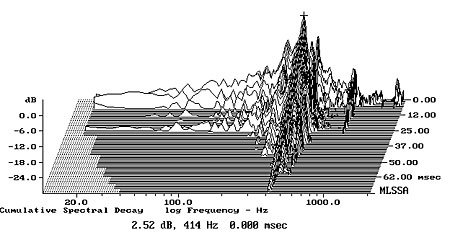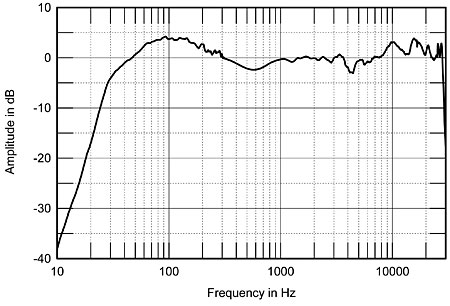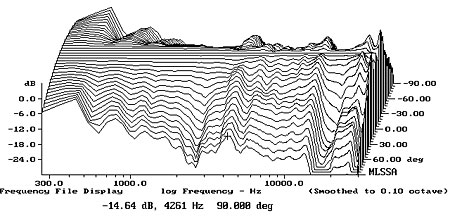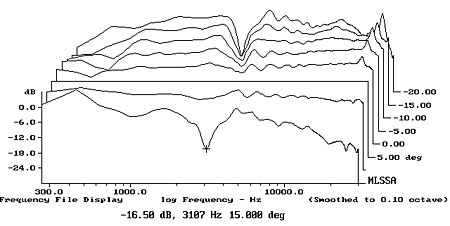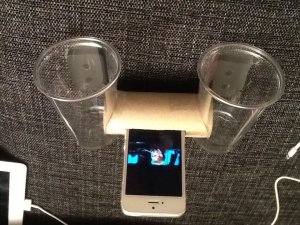Mener jeg har lest at P39 ikke dropper under 3-4 ohm? Stemmer ikke dette?
Klipsch Venner
- Trådstarter Morten_Emil
- Startdato
Diskusjonstråd Se tråd i gallerivisning
-
T
tce-teams
Gjest
[h=2]Klipsch Palladium P-39F loudspeaker Measurements[/h]
Sidebar 3: Measurements Measuring a speaker as bulky and heavy as the Klipsch Palladium P-39F is always problematic: the speaker can't be raised high enough off the ground to eliminate the bounce of its sound off the floor between the speaker and the measuring microphone. I therefore had to use more aggressive time-windowing than usual to generate the frequency-response graphs, which in turn means that these graphs' resolution in the midrange is more limited than usual.
Looking first at the Palladium's voltage sensitivity, my estimate was 94.8dB(B)/2.83V/m, which is within experimental error of the specified 95dB. The P-39F is thus one of the most sensitive models I have encountered in 20 years of measuring loudspeakers—it will play very loud with very few watts. However, the speaker is not as efficient at low frequencies as you might expect; its impedance drops between 3 and 4 ohms in the lower midrange (fig.1), with a nasty combination of 4 ohms magnitude and –50° electrical phase angle at 80Hz. The three woofers do demand a significant amount of current to keep up with the horn-loaded midrange and treble drive-units. The impedance is significantly higher in the region covered by the latter two drivers, averaging 10 ohms, which means that the speaker will sound tilted-up at high frequencies when used with a tube amplifier having a high source impedance.

Fig.1 Klipsch Palladium P-39F, electrical impedance (solid) and phase (dashed). (2 ohms/vertical div.)
The traces in fig.1 are free from the small wrinkles in the midrange that would suggest the presence of cabinet resonances. Nevertheless, investigating the vibrational behavior of the curved panels with a simple plastic-tape accelerometer did uncover a strong resonant mode at 414Hz (fig.2) and another at 520Hz. I note that Wes Phillips mentioned no midrange congestion that might have resulted from this behavior; these resonances may indeed be high enough in frequency to mitigate the resonances' subjective effect.

Fig.2 Klipsch Palladium P-39F, cumulative spectral-decay plot calculated from output of accelerometer fastened to center of side panel (MLS driving voltage to speaker, 7.55V; measurement bandwidth, 2kHz).
Turning to the P-39F's acoustical output, its three woofers behaved identically, as did its three ports. I show in fig.3, therefore, the summed outputs of each array as the blue and green traces, respectively. The ports' output peaks between 28 and 34Hz, as expected from the impedance graph, where the saddle between the two magnitude peaks in the bass occurred at 32Hz. The level of the ports' output is suppressed a little in absolute terms, implying a somewhat overdamped reflex alignment. This is always a good idea with large speakers, because it preserves midbass definition while letting the usual "room gain" at low frequencies give a flat response. There is a small peak in the ports' output at 130Hz, but otherwise the rolloff is smooth. Higher in frequency, the woofers hand off to the horn-loaded midrange unit at 450Hz with what appear to be symmetrical fourth-order filter slopes. The midrange unit looks well behaved in its passband before crossing over to the horn-loaded tweeter at 3.2kHz. Again, the filter slopes appear to be fourth-order or higher. The tweeter also appears well behaved in its passband, but is slightly hot in its top-octave response. The dome resonance occurs just below 30kHz, above which the output drops rapidly.

Fig.3 Klipsch Palladium P-39F, acoustic crossover on midrange axis at 50", corrected for microphone response, with summed nearfield responses of woofers (blue) and ports (green), scaled in the ratio of the square roots of their radiating areas.
Fig.4 shows how these individual outputs sum in the farfield. Klipsch recommends that the listener sit 5° below the tweeter axis, which, at the microphone distance I use for my measurements, is close to the midrange axis. I therefore performed all of my farfield measurements on that axis for reasons of repeatability. The apparent rise in response in the upper bass is mainly due to the nearfield measurement technique—in anechoic conditions, the Palladium P-39F will actually be pretty flat in the bass region. The speaker doesn't go quite as low in the bass as its size might lead one to expect, but this must be balanced against its extremely high sensitivity and the overdamped alignment. In all but very large rooms, the P-39F should give almost the full measure of low frequencies. Other than a slightly elevated top octave, the Klipsch's midrange and treble are impressively flat.

Fig.4 Klipsch Palladium P-39F, anechoic response on midrange axis at 50", averaged across 30° horizontal window and corrected for microphone response, with complex sum of nearfield woofers' and ports' responses plotted below 300Hz.
Whether or not this flat on-axis response translates into a neutral tonal balance will depend on the speaker's dispersion. Fig.5 shows how the Klipsch's response on the midrange axis changes to its sides (only the differences in response are shown). The slight flare at the cursor position is actually due to the on-axis suckout at 4.3kHz filling in to the speaker's sides. The contour lines are otherwise evenly spaced in this graph, which is what matters, but close inspection reveals that the speaker is a little more directional than a typical direct-radiating model in the region covered by its horn-loaded drivers. The tweeter also becomes significantly more directional above 13kHz, which will ameliorate the slight boost in its on-axis output in the same region (for those whose hearing extends that high, of course). I note that Wes didn't toe the Palladiums all the way in to his listening seat, which suggests he gave a high priority to getting a smooth treble balance, while the speaker's well-controlled dispersion over the first 20° to its sides meant he could still get excellent imaging precision and a smooth transition between the drive-units.

Fig.5 Klipsch Palladium P-39F, lateral response family at 50", normalized to response on midrange axis, from back to front: differences in response 90–5° off axis, reference response, differences in response 5–90° off axis.
In the vertical plane (fig.6), a suckout develops in the upper crossover region more than 10° below and 15° above the midrange axis, which is 45" from the floor. Fortunately, Klipsch supplies longer spikes for the rear of the baseplate to tilt the P-39F forward a little, to ensure that the ears of a seated listener are on the intended axis.

Fig.6 Klipsch Palladium P-39F, vertical response family at 50", normalized to response on midrange axis, from back to front: differences in response 20–5° above axis, reference response, differences in response 5–10° below axis.
The Palladiums' spatially averaged in-room response (fig.7), calculated by taking 20 separate 1/6-octave response measurements for the left and right speakers individually in a vertical rectangular grid centered on the position of WP's head in his listening chair, indicates good integration of the speakers' output with the room acoustics, if not quite up to the standard set by the YG Anat Reference II Professional in March 2009 (fig.7) and the Thiel CS3.7 in December 2008 (fig.8). The Klipsch's middle and high trebles are slightly shelved down compared with the other two speakers (especially the Thiel), even though the Palladiums were being driven by the tubed VTL amplifiers, which will tilt up the treble region. The peaks and dips below 300Hz are due to room acoustics effects that have not been eliminated by the spatial averaging. Even so, the Palladiums maintain their in-room low-frequency output to 25Hz or so.

Fig.7 Klipsch Palladium P-39F, spatially averaged, 1/6-octave response in WP's listening room.

Fig.8 Klipsch Palladium P-39F, step response on midrange axis at 50" (5ms time window, 30kHz bandwidth).
In the time domain, the Klipsch P-39F's step response on the midrange axis (fig.8) looks more complicated than the norm, due to the fact that the tweeter's output leads that of the midrange unit by 0.5 millisecond, due to the latter's setback to permit horn loading. Both tweeter and midrange unit appear to be connected in inverted acoustic polarity—the tweeter's step is the sharp negative-going spike just before the 4ms marker, followed by a lazier, negative-going spike from the midrange unit approximately 500µs later. The woofers are all connected in positive acoustic polarity, and their slow rise away from the timeline in this graph overlays the positive-going overshoot of the midrange unit's step. That each drive-unit's step smoothly blends into that of the next lower in frequency correlates with their good frequency-domain integration seen in fig.4. The Palladium P-39F's cumulative spectral-decay plot (fig.9) is basically clean, but with a slight amount of delayed energy apparent at the top of the midrange unit's passband. Peculiarly, this graph also suggests that the woofer/midrange integration is not as good as indicated in fig.4.

Fig.9 Klipsch Palladium P-39F, cumulative spectral-decay plot on midrange axis at 50" (0.15ms risetime).
Overall, this is impressive measured performance, suggesting that Klipsch has some excellent speaker engineers on staff. However, Wes did mention the fact that the P-39F's three pairs of input terminals, positioned in a recess under the speaker's baseplate, elicited much swearing from me. Indeed they did, as this placement made hooking up and dressing speaker cables for the measurements far more difficult than it needed to be. Had Klipsch continued the terminal panel recess out to the rear of the baseplate so that cables could be routed straight back, that would have been a significant improvement in practicality. As it stands, dressing the thick speaker cables Wes likes to use was awkward: even with the P-39Fs sitting on their spikes, there was still not quite enough clearance between the bottom of the baseplate and the floor to avoid trapping the cablesThe P-39F is thus one of the most sensitive models I have encountered in 20 years of measuring loudspeakers—it will play very loud with very few watts. However, the speaker is not as efficient at low frequencies as you might expect; its impedance drops between 3 and 4 ohms in the lower midrange (fig.1), with a nasty combination of 4 ohms magnitude and –50° electrical phase angle at 80Hz. The three woofers do demand a significant amount of current to keep up with the horn-loaded midrange and treble drive-units. The impedance is significantly higher in the region covered by the latter two drivers, averaging 10 ohms, which means that the speaker will sound tilted-up at high frequencies when used with a tube amplifier having a high source impedance.
Jeg tolker dette som en bekreftelse på mine antagelser om at de ikke nødvendigvis trenger så mye watt, men vil ha godt av en skikkelig strømsterk jævel av en forsterker.Selv om det neppe er feil med masse kvalitetswatt heller.
Sjekk ut linken
Et meget godt tilbud det skal være vanskelig å takke nei til!
Klipsch RF-62 - Torget- Ble medlem
- 31.08.2005
- Innlegg
- 1.871
- Antall liker
- 152
Det er den teiteste annonsen jeg har sett
Framoverlent og innovativ markedsføring, det skal du ha.Sjekk ut linken
Et meget godt tilbud det skal være vanskelig å takke nei til!
Klipsch RF-62 - Torget
Ikke når MK II koster 7995 og er en bedre høyttaler. Uansett om du har spilt på de i 400 timerDet må jo være et kjempe godt tilbud!
OBra at du har ombestemt deg Andreas.
Men da er det jo noe helt annetÅjaMen jeg har tatt på de også
O
Har han?Bra at du har ombestemt deg Andreas.Ønsker alle en riktig God Jul! Mvh Øksa
Jepp, god jul til deg Øksa, og alle dere andre Klipsch-befengte stakkarer!Ønsker alle en riktig God Jul! Mvh Øksa
Ho, Ho, HO!! Det var gode nyheter! Goood jul Andy og alle andre Klipsch-gærninger.Det spiller så bra her nå at jeg tror ikke jeg kan bytte de ut enda
Mvh. OleDIY julegaven jeg ga til dama falt ikke helt i smak., men var jo ho som ville holde kostnadene nede.Vedlegg
-
346.7 KB Visninger: 633
GOD JUL til deg Ole og alle Klipsch venner!
Ho, Ho, HO!! Det var gode nyheter! Goood jul Andy og alle andre Klipsch-gærninger.Det spiller så bra her nå at jeg tror ikke jeg kan bytte de ut enda
Mvh. Ole
Hei!
Her kommer et spørsmål fra en amatør:
Er fornøyd med Abrahamsen V1 + V2 og Klipsch Synergy F20 høyttalere.
Mitt spørsmål er: for bedre lyd på filmer og TV, vil det være gunstig å gå til anskaffelse av en Klipsch center høyttaler?
Evt hva annet vil spille godt sammen med resten av anlegget og gi meg bedre lyd?Tja... Det første jeg lurer på er hvordan du skal koble den til. Uten en A/V-receiver med en dedikert senterkanal må vel det hele bli litt vanskelig å få til, og sannsynligvis bare skape problemer.KKaare G. Opsahl
Gjest
Ny Klipsch på soverommet. Den er det et jævlig bra trøkk i
Tror jeg påNy Klipsch på soverommet. Den er det et jævlig bra trøkk i
Vis vedlegget 235113
Har lyst på en slik selv
OHar fått spilt en del på RF-7 nå. Og det virker som Parasound A21 har meget god kontroll på dem. Den gir seg ikke, og det gjør heller ikke høyttalerne. Hadde på Iron Maiden - Wasted years i sta og tenkte jeg skulle teste litt. Var veldig høyt på -15 i reciver men gasset opp til -10. Fy flate det var helt galskap. Går ikke an å høre på engang. Greit å få bekreftet at A21 holder mål. Også imponert hvordan RF-7 låter på middels/lavt volum. Fortsatt ganske engasjerendeBb.helgesen
Gjest
Er det noen som vet hvordan Klipsch rf 82 matcher Abrahamsen ? V1, V2 og V6.Abrahamsen og klipsch matcher helt finfint! Dazed her på forumet kjører vel rent Abrahamsen oppsett mot RF-63 og har ikke hørt noen klager fra den kanten.- Ble medlem
- 31.08.2005
- Innlegg
- 1.871
- Antall liker
- 152
Tror ikke du bommer med rør på HIII. Hadde jeg eid de hadde jeg gått for rør. Med 2 x 10 kvalitetswatt synger nok disse så det griner.
Det kan jeg så absolutt bekrefte.Abrahamsen og klipsch matcher helt finfint! Dazed her på forumet kjører vel rent Abrahamsen oppsett mot RF-63 og har ikke hørt noen klager fra den kanten."Spellær som faen" som det heter her i Østfold.
Skulle tro at RF82 ville funke bra også.
Jeg har bare prøvd McIntosh og Krell på mine HIII, men jeg syns Krell funker bra selv om det muligens er overkill med 250 watt på dem. Men er greit med litt headroom. Men det jeg vil fram til, hvis du finner transistorforsterkere med lavt støynivå som ellers låter bra, så kan det funke veldig bra det også selv om de aller fleste anbefaler rør til Heresy.Noen her som har prøvd mye forskjellig av forsterkere på Heresy III ? Hva er din absolutt beste match ?
Lurer litt på rør da de virker utrolig lettdrevne.
God Nytt År til alle
Kunne forøvrig tenkt meg å prøve rør selv også siden det er hva flertallet anbefaler, men det er et par ting som gjør det uaktuellt for min del akkurat nå. Det ene er at balanserte rørkonstruksjoner hverken er billige eller vokser på trær, det andre er at det er stress med rør som må biasjusteres, rør som ryker, og det at man helst bør passe på å skru av elektronikken når man ikke bruker den.
Et annet alternativ å sjekke ut kan være rene klasse A transistorforsterkere som f.eks. Sugden eller diverse Nelson Pass konstruksjoner.- Ble medlem
- 31.08.2005
- Innlegg
- 1.871
- Antall liker
- 152
Godt nytt år ja!
Men husk at en del rørforsterkere har autobias. Ikke er det så mye å sette seg inn i rørene til den forsterkeren man har valgt heller uten at det koster skjorta. Det er faktisk litt morsomt å lese seg frem på rør. Min har kun to forskjellige, så det går greit. Og de varer leeenge.
En god rørforsterker trenger heller ikke å koste en formue selv om en noen mener det. Man får en god røramp brukt til 10k. -
Laster inn…
Diskusjonstråd Se tråd i gallerivisning
-
-
Laster inn…




